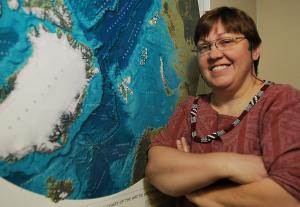Lecture explores munitions dumped near Hawaii
University of Hawaiʻi at MānoaContact:
Posted: Oct 28, 2009
UH Mānoa will host the Achievement Rewards for College Scientists 2009 Scientist of the Year lecture: "Hawai‘i Undersea Military Munitions Assessment" on Tuesday, November 10 at 5 p.m. at POST 127. Margo Edwards, researcher with the Hawai‘i Institute of Geophysics and Planetology, School of Ocean and Earth Science and Technology at UH Mānoa, was named the 2009 Scientist of the Year by Achievement Rewards for College Scientists–Honolulu in recognition of her research group’s work in advancing understanding of the sea floor.
Edwards will describe recent surveys identifying discarded military munitions dumped in the ocean south of Pearl Harbor since the late 1940s. Edwards will also talk about the Hawaiʻi Mapping Research Group's (HMRG) 12-day research cruise aboard UH's R/V Kaimikai-o-Kanaloa.
As director of the Hawai‘i Mapping Research Group, Edwards oversaw development and operation of new underwater mapping tools. Since joining UH’s Hawai‘i Institute of Geophysics and Planetology in 1991, she has advanced seafloor mapping using sidescan sonar and multibeam bathymetry data and published widely on the geologic clues these techniques have provided in areas ranging from volcanic processes at mid-ocean ridges to impact of ice sheet drainage on the Arctic seafloor. For the latter project, Edwards was the first woman to live aboard a Navy nuclear submarine as it pulled the seafloor mapping towfish under the Arctic icecap for 12 days.
Funded by the Army’s Hawai‘i Undersea Military Munitions Assessment project, Edward’s undersea mapping team has been using sidescan sonar to locate munitions, as well as UH submersibles and a remotely operated vehicle to identify the munitions (about 2,000 to date) and collect water, sediment and sea life samples for laboratory analysis to assess presence of chemical agents, metals and energetics. In the meantime, HMRG mapping of the dump site will allow submersibles to operate more safely within the 27-square-mile area.
Achievement Rewards for College Scientists (ARCS) is a national nonprofit organization that raises funds to support graduate students in the sciences, engineering and health fields. Since it was founded in 1974, the ARCS–Honolulu chapter has provided more than $1.7 million to doctoral students at the University of Hawai‘i at Mānoa.

